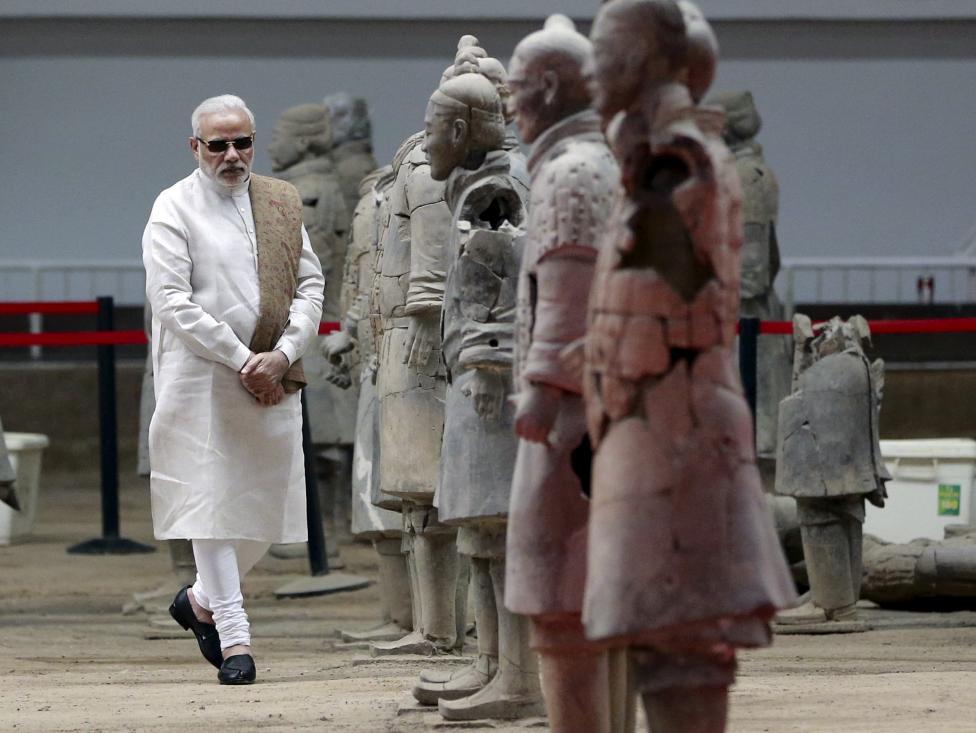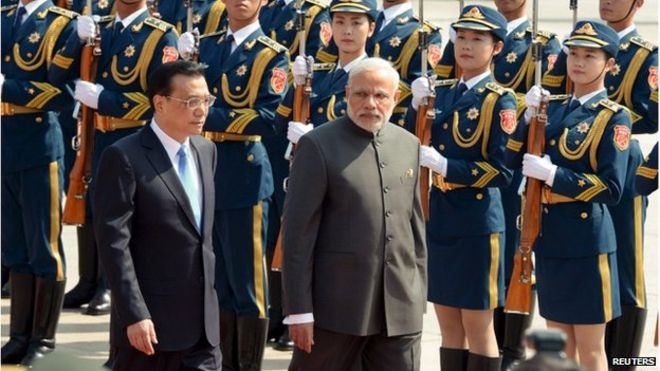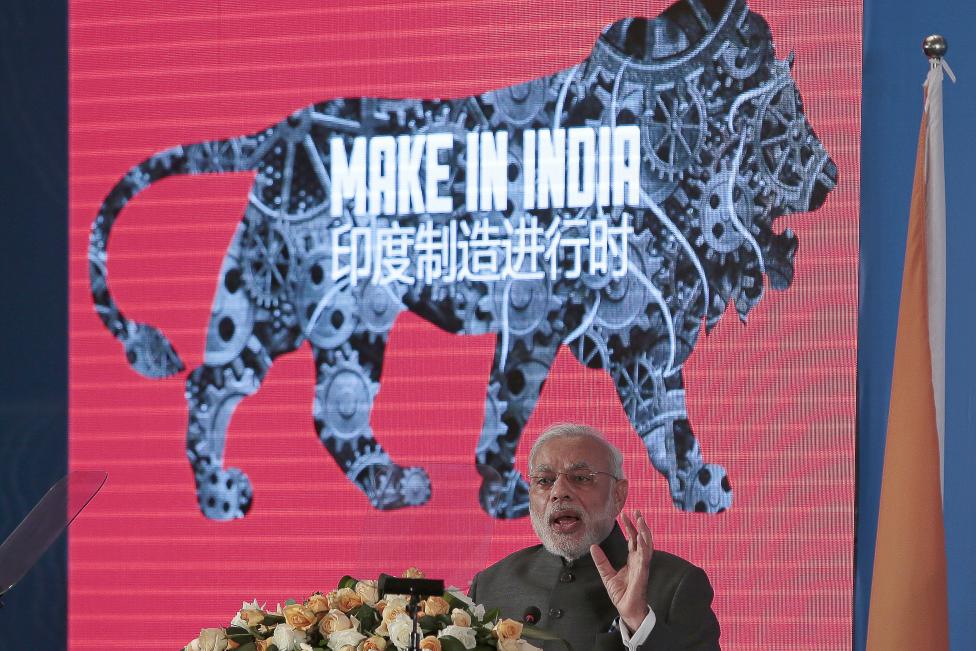When the Prime Minister of India Narendra Modi went on his three-day visit to China on 14-16 May, 2015, a tremendous amount of interest was generated in both countries. Other than strengthening ties and deepen bilateral relations and was a milestone for the relations between developing countries in Asia and around the world.

Mr Modi received a golden Buddha statue from an abbot at the Dacien temple in Xian, China
Photo: Reuters
On the first day of his arrival, there was much Chinese culture to be taken in – right from the dances by the Tang dynasty to the visits to the Terracotta Warriors Museum, Daxingshan Temple and the Big Wild Goose Pagoda. But more important were the extensive talks with President Xi Jinping about issues such as boundaries, peace, trade imbalance, connectivity and terrorism, among others, to enhance ties, as announced by S Jaishankar, Foreign Secretary. The two world leaders also seemed to bond on a more personal level after Xi’s recent visit to India last September. This was clear when the PM gifted him replicas of a stone casket of Buddhist relics and a stone statue of Buddha that were excavated from the 3rd-4th century stupa at Dev-ni-More near Gujarat. He also presented Xi with archaeological drawings of excavations at Vadnagar, which was once visited by the famous Chinese traveller Hieun Tsang around 641 AD.
The second day was marked with the signing of over 20 bilateral agreements, covering diverse areas of co-operation. On the boundary issue, there is to be clarification of the Line of Actual Control, trans-border rivers, an enhanced border defence co-operation with a hotline to work between the Military Headquarters and the extension of electronic tourist visas to Chinese nationals. There will also be annual visits and exchanges between the two military headquarters and neighbouring military commands. Most importantly, peace and tranquility on the India-China border has been recognised as an important guarantor for the development and continued growth of bilateral relations.

Mr Modi visits the Museum of Qin Terracotta Warriors and Horses, in Xian, China
Photo: Reuters/China Daily
Common global and regional interests were expressed, for example the shared interest in international climate change negotiations, emphasising the importance of working together and with other countries to conclude an ambitious, comprehensive, universal, balanced and equitable climate agreement at the forthcoming Paris Conference. Combating terrorism was also brought to the table, with both parties agreeing that terrorism is not justified and to urge all countries to disrupt terrorist networks and their financing, and stop cross-border movement of terrorists.
The two sides also agreed to broaden cooperation in SAARC, strengthen coordination and cooperation in multilateral forums including RIC, BRICS and G20 and recognized that APEC has a significant role in advancing regional economic integration. They also collectively supported a comprehensive reform of the United Nations.
It was also decided to “take the relationship out of the narrow confines of governments in the national capitals to states, cities and our people”. With 2015 being the Year of India in China and 2016 the Year of China in India, tourism too will expand in both countries, and the Nathu La route for Indian pilgrims to visit Kailash Mansarovar, for instance, will become operational in June. To promote greater cultural, tourism, economic and people-to-people engagement, an additional Consulate General will be established in each other’s country, with China opening theirs in Chennai and India in Chengduto. Agreements on establishing a provincial partnership between Karnataka and Sichuan and sister-city relationships between Aurangabad – Dunhuang, Chennai – Chongqing, and Hyderabad – Qingdao were also welcomed. As a means of fostering closer dialogue, the two sides also established an India- China Think Tanks Forum, which will meet annually.New avenues for co-operation were also opened up in the peaceful use of outer space and nuclear energy, in the sphere of public health, medical education and traditional medicine, with the Indian Space Research Organisation and China National Space Administration agreeing to sign a Space Co-operation Outline for Deep Space Exploration. Lastly, both countries agreed to tackle the growing trade deficit by expanding economic relations in infrastructure, IT, pharma, agriculture and manufacturing.
On the last day of his China visit, Modi met Chinese CEOs in an attempt to invite them to participate in his Make in India campaign using the 5F Formula – From Farm to Fibre to Fabric to Fashion to Foreign! Over the course of the meeting, he signed 21 business agreements worth $22 billion. Following this, he launched the Centre for Gandhian and Indian Studies at Fudan University, where he said that the two countries have historical and civilisational ties and can together create a world that serves humanity.
But one of the most unforgettable parts of the trip was his speech later that day, while addressing a crowd of over 5,000 members of the expatriate Indian community at the Indian Community Reception in Shanghai. Taking a dig at previous Indian governments, he said that in his one year as PM, he tried to complete 30 years of work, saying “I am criticised for working hard. If working more is a crime, I will keep doing it. My commitment is to the people.” But when he said “Now you feel proud to represent the country. Indians abroad had all hoped for a change in government last year”, the words rubbed many Indians the wrong way, sparking an online controversy and the Twitter hashtag #ModiInsultsIndia.
He concluded his three-day China visit with the words “I see this visit in a different way. It has laid strong foundations which will benefit coming ages”. Noting that China has changed in 30 years and not overnight, he said, “India too will have to improve growth, progress in IT, Research and Development. Once we move towards a new age, we can give something to the world. In every respect, we will take the country forward. It is our resolve.”






 Print
Print Email
Email